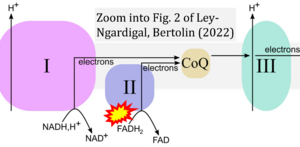Ley-Ngardigal 2022 FEBS J
| Ley-Ngardigal S, Bertolin G (2022) Approaches to monitor ATP levels in living cells: where do we stand? FEBS J 289:7940-69. https://doi.org/10.1111/febs.16169 |
Ley-Ngardigal S, Bertolin G (2022) FEBS J
Abstract: ATP is the most universal and essential energy molecule in cells. This is due to its ability to store cellular energy in form of high-energy phosphate bonds, which are extremely stable and readily usable by the cell. This energy is key for a variety of biological functions such as cell growth and division, metabolism, and signaling, and for the turnover of biomolecules. Understanding how ATP is produced and hydrolyzed with a spatiotemporal resolution is necessary to understand its functions both in physiological and in pathological contexts. In this review, first we will describe the organization of the electron transport chain and ATP synthase, the main molecular motor for ATP production in mitochondria. Second, we will review the biochemical assays currently available to estimate ATP quantities in cells, and we will compare their readouts, strengths, and weaknesses. Finally, we will explore the palette of genetically encoded biosensors designed for microscopy-based approaches, and show how their spatiotemporal resolution opened up the possibility to follow ATP levels in living cells.
• Bioblast editor: Gnaiger E
Correction: FADH2 and Complex II
- FADH2 is shown as the substrate feeding electrons into Complex II (CII). This is wrong and requires correction - for details see Gnaiger (2024).
- Gnaiger E (2024) Complex II ambiguities ― FADH2 in the electron transfer system. J Biol Chem 300:105470. https://doi.org/10.1016/j.jbc.2023.105470 - »Bioblast link«


